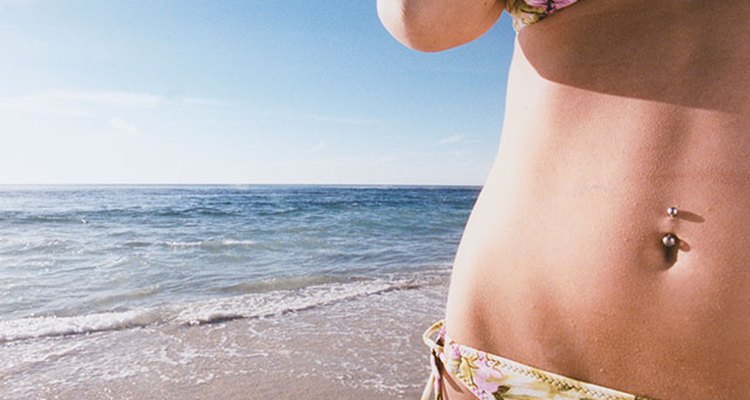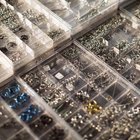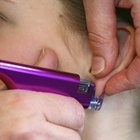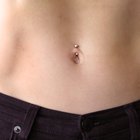
Woman With Navel RingWoman with Navel RingDownloadEric O'Connell/The Image Bank/Getty Images
While body piercings may be considered a fashion statement or an adornment, in some cultures body piercings are considered part of a spiritual journey. Believers of Hinduism or alternative medicine believe that piercing the belly button aligns or improves function of the third chakra, the solar plexus. The solar plexus controls emotions, such as willpower and self-esteem, and rules organs in the torso, such as the pancreas and kidneys. In this belief system, the belly button piercing acts as a “gatekeeper” to hold positive energy inside the body while preventing negative energy from entering.
History and Background of Body Modifications
Cultures all around the world have a rich history of body modifications going back centuries. "Body modification" can range from piercings and tattoos to more extreme acts like neck stretching or teeth sharpening. In the U.S., body piercings and tattoos are becoming more and more common: A 2012 poll conducted by Harris Interactive showed that one in five American adults has a tattoo. Among Millennials, a 2010 survey by the Pew Research Center found that 1 in 4 has a body piercing in "some place other than an earlobe."
Getting a Belly-Button Piercing
A traditional belly-button piercing is in the top half of the navel. A piercer creates a star or square shape by piercing the upper and lower lips of the navel along with two or more surface piercings on the sides of the navel.
But belly-button piercings aren’t for everyone: You need to have the proper “navel anatomy.” The top flap of the navel must have enough room for the piercing to hang inside the navel without pressure from the top or bottom. If you don’t have room on the top flap, piercing the bottom flap instead may be an option. A professional piercer will ask you to sit down and bend over to determine if a navel piercing is right for your body.
If you have a belly button that closes, or “winks,” when you sit down, piercing is usually not an option. The pressure caused by the top and bottom of the navel meeting when you sit can cause irritation to the piercing and force the jewelry to migrate. “Outie” belly buttons, or herniated umbilicus, are dangerous to pierce. If an infection occurs during the healing process, the infection can travel to the intestines or other organs. Blood vessels are prominent in this area and a piercing can also cause excessive bleeding. Professional piercers will refuse to pierce “outies” for these reasons.
Health Risks of Belly-Button Piercings
A bacterial infection at the site of the piercing is the most common risk. According to a Northwestern Medicine paper published in the American Journal of Clinical Dermatology, about 20 percent of body piercings become infected. Other risks include:
- allergic skin reactions to the jewelry used in the piercing - scarring - loss of blood/excessive bleeding - tearing (if it gets caught on something) - jewelry rejection or migration
The risk of a bacterial infection is even higher if you have certain pre-existing medical conditions, such as diabetes or a weakened immune system or if the piercer uses unsterile equipment. You can reduce your risk by making sure your piercer belongs to the Association of Professional Piercers (APP). While it doesn’t certify or license piercers, it encourages members to APP standards. At a piercing salon, don’t hesitate to ask about their safety standards.
While ear or lip piercings usually heal in about 6 to 8 weeks, the healing period for a navel piercing is much longer -- about six months to one year.
How to Care for a Belly-Button Piercing
Check your piercing daily for any signs of irritation, swelling or redness. For the first few days after your piercing, it's normal for a belly-button piercing to ooze some discharge, but if it continues for more than a week, consult your piercing studio or a doctor as soon as possible.
You can reduce the risk of infection even further by taking proper care of your piercing while it heals. Here are some tips for caring for your piercing:
- Avoid touching the site or the jewelry, aside from cleaning. - Wash the piercing and jewelry with soap twice a day by hand and pat dry with paper towel. Washcloths, loofahs and towels can harbor bacteria and may catch on the piercing and tear. - Avoid over-cleaning; too much cleaning can irritate your skin and delay the healing process. - Don’t wear tight-fitting clothing on or above the piercing. Your piercing needs oxygen to heal and friction can cause irritation and delay healing even further. - Avoid swimming in public pools or using public hot tubs as water-borne bacteria could enter the piercing site. - Don’t apply antibacterial ointments which could actually trap bacteria inside.
Removing or Changing a Belly-Button Piercing
When you remove your piercing for the first time, make sure you follow a few basic steps:
- Don't remove the piercing until after it has completely healed; if you don't, removing it could cause the hole to shrink or close.
- Wash your hands, the piercing and belly button area.
- Twist or slide the piercing back and forth to make sure your skin hasn't adhered to the piercing. If it doesn't move freely or you experience any pain, you should go back to your piercer and have them remove it.
- If you're able to remove the piercing without pain or difficulty, make sure you wash the piercing site AND the new piercing before inserting it.
Related Articles

The Disadvantages of a Belly Button Ring

How to Prepare for a Nose Piercing

How to Get Rid of a Piercing That Won't ...

Facts on Nose Piercings

How to Get a Guiche Piercing

How to Soothe an Irritated Piercing

How to Clean Nose Rings

Reactions to Nose Piercings

Professional Way to Clean an Eyebrow ...

How Long Should I Wait to Get My Nose ...

How to Drain a Cheek Piercing
How Long Should I Wait to Change My ...

The Pros & Cons of Getting Your Belly ...

Complications of Nipple Piercing

How to Clean a Tongue Ring

Ear Piercings & Swimming

What Is Bio-Flex Made of for Piercings?

How to Remove a Navel Piercing

List of Body Parts That Can Be Pierced

How to Change Pierced Earrings
References
- Safe Piercing: Navel Piercings and Pregnancy
- Safe Piercing: Suggested Aftercare Guidelines for Body Piercings
- When Body Piercings Go Wrong
- American Academy of Dermatology: Tattoos, Body Piercings and Other Skin Adornments
- Complications of Body Piercing
- Body Piercing
- The Association of Professional Piercers
- The Pew Research Center
- National Geographic Channel: Neck Rings of the Kayan Women
Writer Bio
Maude Coffey retired after 10 years working as a professional body modification artist in the tattoo industry. She is certified in principles of infection control and blood-borne pathogens. Coffey received additional training and classes, such as anatomy, jewelry standards and aftercare, from the Association of Professional Piercers. Coffey aims to educate about safe tattooing and piercing practices while writing for various websites.
Photo Credits
Woman With Navel RingWoman with Navel RingDownloadEric O'Connell/The Image Bank/Getty Images